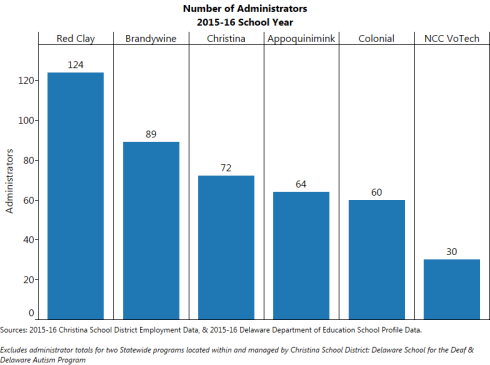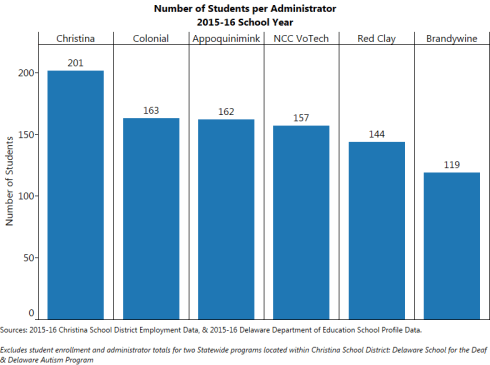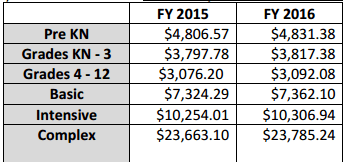What Brought the No Votes to Christina? Part I
A commenter on my earlier post about supporting public education and “Super Referendum Wednesday” asked specifically about the Christina School District’s two failures last year and if there were any themes from no voters about why they voted the way they did. Rather than answer it inline, I felt those themes deserved their own posts for visibility sake so the misinformation we have campaigned against for the last several years is out in the open.
Yes, there are common themes among the no-voters that emerged from both elections, and they persist today. Check out the CSDpavingtheway or Official District Facebook pages for proof. Better yet, read the comments on any article the News Journal posts about Christina on delawareonline.com, just be sure to have your eye bleach ready.
Theme 1: Top heavy, bloated administrator staffing – if only the fat-cat administrators would sacrifice themselves, teachers could be saved! Over 100 administrators make over $100k a year!
- Wrong. Why? Christina doesn’t have 100 administrators, last year there were 78. This year, 72. 50 are school leaders, 22 are district administrators.
- Well, what about the bloated 100+ $100K salaries?! In FY16, there are 87 employees that earn $100k and they are not all administrators and that is out of 1,837 district employees. 95% of Christina employees make less than $100k/yr.
- But Delaware Department of Education says the District has 90 Administrators right on their site!
- That is because Christina has the distinction (and honor in my opinion) of managing two Statewide Special Programs on behalf of the State of Delaware: Delaware Autism Program and Delaware School for the Deaf and because Christina manages them their totals roll into Christina’s numbers on DOE’s site even though they are not part of the Christina School District. (Remember this piece of information, it’s important)
- In total the Special Programs have 15 administrators. Add to 72 and that gets us 87. Still not 90, but if you round-up I guess it’s close enough?
- How does Christina stack up to neighboring NCC districts in terms of administrator positions? Here’s the total number of administrators by District in New Castle County:
- Christina Administrator Breakdown across 26 traditional schools:
- 24 Principals
- 26 Assistant Principals
- 3 Directors (Elementary, Secondary, and Special Ed)
- 10 Supervisors (transportation, maintenance, facilities, etc)
- 7 Managers (financial, business, program, etc)
- 1 Superintendent
- 1 Assistant Superintendent
- 50 of the 72 positions (70%) are school leadership positions.
As you can see from the above breakdown, Christina has 26 traditional schools but only 24 principals. Why? Schools must hit a threshold of student enrollment to “earn” a Principal funding unit from the State. If they don’t hit the threshold, they don’t get state funding for a principal, even though they are a functioning school. There are principals in all schools in Christina, but district taxpayers must make up the difference in salary between assistant principal and principal in the schools without an “earned” principal.
This is the Student to Administrator ratio for the NCC districts.
For every 1 administrator whether it be district or school, there are 201 students. The number is even more absurd when you only calculate for principals and assistant principals (50): 14,502/50 = 290 students per School Administrator.
This is a comparison of student enrollment and administrator totals.
Orange bars: Total student enrollment. Blue/black lines: Administrator totals. Notice the apparent correlation between the admin and enrollment totals for each district. See any outliers?
The District employs 1,047 teachers and 97 paraprofessional aides. That means 62% of the staff are educators. The District has 72 Administrators making up 4% of all employees. District Level admins make up 1.2% of the employee list meaning 98.8% of Christina employees are either in School Buildings or are directly affiliated with school buildings (bus drives & aides, curriculum specialists, etc).
TL;DR: Christina has, by far, the LARGEST student to administrator ratio in the County and has disproportionately fewer administrators than our sister districts despite being the 2nd largest school district by student enrollment. Yet Christina continually gets yelled at for being “top-heavy”.
Theme 2: Christina spends more per student than [insert other district name here] and still performs worse! Why do they need more out of MY pockets?
There’s an important distinction in the phrasing of this question. People who ask this question want to know what amount of property taxes go to each student. They’re not asking what the total from the State, Federal and Local shares are. They want to know what THEIR collective property taxes pay for and the answer is a hot mess.
- The ‘expenditure per pupil’ statistic on Delaware DOE’s site is probably one of the worst non-standardized test related data points ever created for education. (Kevin O. if you’re reading this, that qualification is for you). Whoever thought it was a good idea to display it that way should be fired. It reads “District Expenditure per Pupil”. Purposefully misleading if you ask me because the number includes State and Federal funding in addition to local District funding (from property taxes), AND it has Special Ed funding for programs not exclusive to Christina rolled into it.
- Every student has different levels of educational needs, levels which need different resources. Those resources cost money and as such, cost per student varies depending on the student’s needs.
- Local (Property Tax) funding in DE has 3 “tiers” of general education funding and 3 “tiers” of special education funding, each with its own $ amount attached per student. See below:
The State sets the categories and amounts. Basic, Intensive, and Complex funding is reserved for students with increasing levels of need beyond general education, with Complex representing the highest need level.
- If Jim Bob Christina-Homeowner wants to know what property taxes pay for (which is what we get asked), we have to exclude State Funding and Federal funding and only look at the local share of funding, represented in the table above.
- To do the math on an ‘average’ In-District (as in local taxpayer-funded) expense for a Christina School District student at first glance you might think to add the amounts in the “FY16” column and divide by the number of student funding categories (6) to get an ‘average’ of $8,865.85 per student. But this method is only correct if the same number of students are in each category, and that is far from the case.
- As of FY16, 91% of Christina’s local share of per student expenses goes to the general education categories of student funding (Pre KN, KN-3, 4-12). In-District students categorized under the three special education categories make up the remaining 9% of the student population.
- When you control for that allocation, the average Christina School District Expense from Local Taxpayers per student is: $3,982.33. An oh-so slightly different amount than the one portrayed on DOE’s site.
- By the way, know what one of the biggest influences on a student’s ability to achieve and succeed in school is that isn’t represented in education funding anywhere in Delaware? Poverty. Higher level of poverty = greater difficulty in academic success. The only place poverty is represented in Delaware Education is in Standardized Test Scores, and the food & clothing pantries in schools, and the cafeterias where schools host family dinners…
Why DDOE uses such levels of obscurity and makes it that hard to figure the property owner’s share of funding out I have no freaking idea. But there is your average local taxpayer share of per student funding in Christina; $3,982.33. I do not know what our neighboring districts’ property owners spend per student, and I’m not figuring it out. My brain is shot and it’s only 3pm on Monday. Perhaps we could ask the other District’s Citizen’s Budget Oversight Committees to determine it. And why DOE requires Christina to roll up all DSD and DAP figures as part of the District’s also baffles my brain.
Is there a reason DOE can’t separate out Special Programs, State Share per Student, and Local District Share per Student on their site? Hell if I know.
TL:DR; We probably don’t spend the most per-student but how the hell are we supposed to explain that to the average homeowner who has no clue how complex this is and only pays attention to it during referendum (tax-hike) time and just votes on “More Taxes?” or “Not More Taxes?” ?!
There’s two of the overarching themes. I literally can’t handle sharing more now. I’ll get to it over the next week and a half leading into Super Referendum Wednesday.
My overarching theme is, how are we supposed to explain this mess to voters who are only interested in it once every 3-5 years? More to come.
Tags: Christina School District, Education, funding, property taxes, referendum







Impressive, Brian. Thanks for doing all this work!
As far as per student funding, I’ve never understood why people didn’t understand the definition of the word average.
as usual a good job here!
DDOE doesn’t make it easy to understand the word ‘average’ either because it has several contexts. “Average” General Ed student? “Average” Spec Ed student? “Average” State, Federal, Local or combined expenses? DDOE has nice pie charts showing the breakdown of State vs Local vs Federal revenue, not sure why they can’t do that for expenses.
What’s your definition of average?!
Another possible reason for no votes in the upcoming referendum? Robocalls from some shadow group in Milton, DE:
http://wdel.com/story/73995-downstate-political-group-launches-robo-call-opposing-christina-referendum
“First State Liberty”.
Yeah, we heard from that group last year, with numbers calling from Milton, DE.
All their info was incorrect last year and it’s the exact same message this year, so it hasn’t been updated since. It’s REALLY incorrect this year given all the cuts.
There was response issued by Superintendent Andrzejewski and our Referendum Committee:
http://christinak12.org/apps/news/show_news.jsp?REC_ID=395996&id=0
http://csdpavingtheway.com
Nice job Brian. And the most detailed answer I’ve ever seen to a question. One takeaway would be that the use of the term “administrator” serves no particular purpose, but contributes significantly to a negative perception. Almost no one would argue that each and every school should have a principal or that every district have a superintendent.
There could be an argument that the Manager and Supervisor functions might benefit from some analysis to see if whether a functional or matrix alignment could achieve some efficiency, but mostly that would be arguing about the margins. So why use the term “administrator”? I have a feeling it is there because people felt a need to categorize the entire set of functions that are not “teachers” to balance out the set.
Second takeaway. I think you are spot on in that people want to know where the money from their property tax bill is going. Although I would caution that they are also concerned about how much money in general is being spent regardless of the source because they are ultimately paying for it regardless.
Even so, spending per pupil as a measure seems to consist of throwing everything in the pot and then dividing by the number of pupils. I would suggest that certain things such as infrastructure should not be included in that pot. A further refinement, there are finance/budgeting terms common in the federal government and industry: direct/indirect recurring/non-recurring and general and administrative operating expenses that should be employed when calculating things.
Direct costs are those budget line items that support performing the scope of work and are reasonable, easily identifiable and allocable to the project.
Indirect costs are expenditures that cannot be allocated to a specific project (e.g. teaching students). Indirect costs are collected and expressed as a percentage of the direct costs. Indirect costs normally pay broad categories of costs such as sponsored programs administration, research compliance, purchasing, accounting, libraries, custodial services, building depreciation, and utilities.
These types of criteria are similar to how charities are evaluated: http://www.charitynavigator.org/index.cfm?bay=content.view&cpid=1284#.VuhE9HxFCt5
I’m not suggesting that people would immediately comprehend the distinctions but it would provide an better and more consistent method of explanation.
Finally, I would ask why people are not exposed to this more than once every 3-5 years. Shouldn’t they see it every year? Shouldn’t there be some obligation to report budget versus actuals? Shouldn’t there be a P&L every year? Should there be some measures of budget performance other than “we spent what we got.” Measures of Effectiveness (MOE) are measures designed to correspond to accomplishment of objectives and achievement of desired results. Those measures should not be one of those things that get done prefatory to asking for more money. Exposing the people to things like this every year would be one way of educating them so that the explanations start to make sense for them.
Various funding sources may require certain reports that have things categorized in a certain manner, but certainly the district is free to create other reports with Special Education extracted and displayed properly.
My finally thought is that in communications we require both a transmitter and receiver but it’s more involved than that, both the transmitter and receiver must be tuned to the same frequency AND they must both be using the language construct for communication to take place.
Dude! (Brian)
Thanks.
Thanks for the work!
You missed one of CSD neighboring districts, which is understandable because it’s in Maryland. Cecil County Public Schools boarders CSD on it west. If you look at their administrative numbers it strengthens your data. They have 101 administrators and they have just about the same amount of students as CSD. While Cecil County has slightly more teachers you can find a huge departure in staffing models on paraprofessionals. Cecil has more than twice the amount of Paras then CSD. But here is the cut, if you take CSD budget and cut the choice/charter numbers out they still out spend Cecil County while maintaining less staff. Bottom-line our neighbors to the west are putting more staff in classrooms for less money and we awe to ourselves to ask how.
You can say that the two districts are apples and oranges, but I think it’s more like they are two different varieties of apples, which can be compared. CDS has more title one students, which is a greater objective challenge and they have higher transportation cost because of choice. The two schools systems have different state laws and contractual agreements. These costs can be calculated and should be. If CDS could be doing more with less that would strengthen the argument for the referendum, but at the same time we may be able to learn from our neighbors how to increase our staff to student ratio while limiting costs. It would take some work to understand the numbers, but worth the effort.
Pat – do your numbers control for the two special education programs above? Because in some cases, the special education programs have extremely high student to staff ratios (think 2:1 or 3:1. If fact, I’ve seen 1:2 in some extreme cases). And they don’t just educate the students of Christina at the special ed programs, so they have a higher percentage of identified students than Cecil.
Delaware borders three states with some of the best public schools in the country: New Jersey, Maryland, and Pennsylvania. We chose Delaware precisely because the taxes are low. If I wanted to send my kids to public school, we would move them into one of those states. This is the reason I have voted no and will continue to vote no to Christina referendums. Delaware cannot compete with the public schools in its neighboring states, and it shouldn’t.
http://www.usatoday.com/story/money/business/2015/01/15/247-wall-st-states-best-schools/21388041/
There have been some very dishonest and disingenuous tactics used by certain groups outside the Christina community to disenfranchise and misinform you, the voting public, and sway you to oppose the welfare of the children in Christina. A pattern has emerged of persistently and falsely stating that the district is swollen with an unnecessarily large bureaucracy. The documented truth is that in recent years Christina has trimmed its administration staff by a huge number and has markedly fewer administrators than districts with smaller student populations and special needs obligations.
As of March 4, 2016 the District had 2,615 Employees, and a total of 84 administrators, the majority of whom are professional leaders of schools and programs. Here is the current list of administrators. “Special Schools” include the statewide programs at Delaware School for the Deaf, Delaware Autism Program, and REACH program for students with severe special needs. “Supervisors” oversee operational areas such as transportation, child nutrition services, financial services, and other services that are tied to students.
As a District, Christina has less Administrators this year than last year. Specifically, they have reduced the Central Office by 6 Administrators, and have 2 Senior Administrative positions authorized and unfilled. Currently they have 65 Administrators paid with a combination of State and Local Unrestricted Funds (Operating Tax). This breaks down as:
Superintendent 1
Assistant Superintendent 1
Director 3
Principal 23
Assistant Principal 24
Supervisor 7
Manager 6
Grand total 65
They also have additional Administrators funded with a combination of Federal Funds, Restricted Local Funds, or 100% State programs. These programs include the Delaware School for the Deaf, the Delaware Autism Program; REACH/ILC Programs; Adult Education; and Parent Early Education Program. This breaks down as:
Special Program Director 2
Special Program Principal 4
Special Program Asst. Principal 8
Special Program Supervisor 5
Grand total 19
You can see from the above (both tables) that the vast number of Administrators (70%) are directly tied to Schools.
These numbers reflect a very efficient and bare bones administrative staff that is absolutely necessary to ensure a quality education for all of our children.